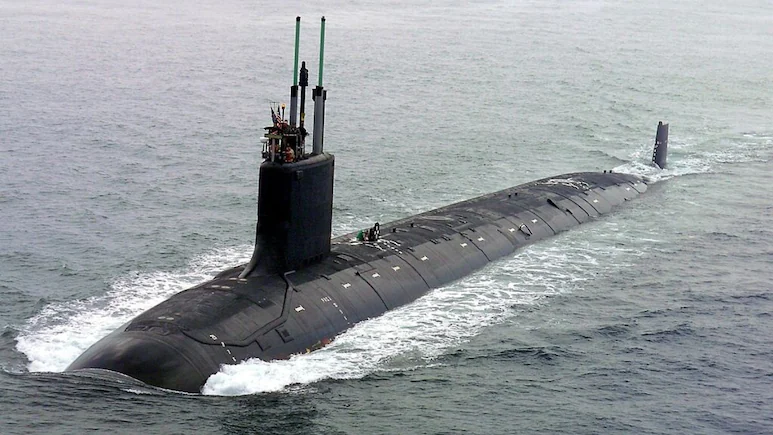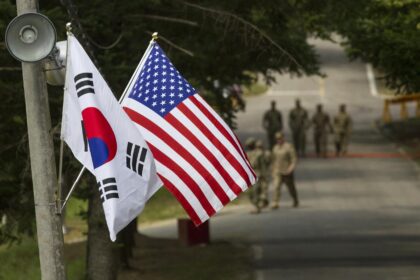Beneath the Surface – The Strategic Depth of the US Nuclear Submarine Programme
The Silent Backbone of Superpower Strategy
Far beneath the ocean’s surface, invisible to satellites and unreachable by most modern weapons, lies a cornerstone of American military dominance: the United States’ nuclear submarine programme. These silent steel leviathans—each a fusion of cutting-edge technology, raw firepower, and clandestine intelligence-gathering capability—form a critical pillar of the United States’ nuclear deterrent and global strategic influence.
While aircraft carriers and fighter jets capture public imagination, it is the nuclear-powered, nuclear-armed submarines that ensure the United States always has a second-strike capability—ready to retaliate even in the face of a first-strike attack. And in today’s world of escalating geopolitical friction and underwater arms races, their importance has only grown.
This article dives deep—into the origins, evolution, infrastructure, geopolitical ramifications, and emerging threats facing the US Nuclear Submarine Programme. Part 1 begins with the historical roots and core strategic rationale of the programme.
Origins of the Programme: From Nautilus to Nuclear Doctrine
The story began in 1954 with the launch of USS Nautilus, the world’s first operational nuclear-powered submarine. It wasn’t just a breakthrough in naval propulsion; it was a revolution in underwater endurance. For the first time in history, a submarine could stay submerged for months, limited only by food and crew stamina.
This innovation—led by visionary Admiral Hyman G. Rickover—laid the foundation for what would become a sprawling and ultra-secretive component of U.S. national security. By the 1960s, the U.S. Navy had fielded its first ballistic missile submarine (SSBN), USS George Washington, capable of launching nuclear missiles while hidden in the deep sea.
Over the decades, the doctrine of Mutually Assured Destruction (MAD) leaned heavily on these submarines’ ability to survive a nuclear exchange and retaliate. This deterrent value remains central even in 2025.
The Triad and the Underwater Leg
The United States maintains what’s known as the nuclear triad:
- Land-based ICBMs (Intercontinental Ballistic Missiles)
- Strategic bombers capable of nuclear payloads
- Submarine-Launched Ballistic Missiles (SLBMs) from nuclear submarines
Of these, the SLBM-carrying Ohio-class SSBNs are considered the most survivable. Capable of disappearing into the ocean’s depths for extended patrols, they are nearly impossible to detect or track reliably, even with modern sonar and satellite technologies.
Each Ohio-class submarine carries up to 24 Trident II D5 missiles, each with multiple independently targetable reentry vehicles (MIRVs), meaning a single vessel could deliver dozens of nuclear warheads—each with megaton-level destructive capacity.
The Fleet: Classes, Capabilities, and Deployments
The US Navy currently operates four key classes of nuclear-powered submarines:
- Ohio-class SSBNs (Ballistic Missile Submarines)
- Role: Strategic nuclear deterrence
- Armament: Trident II missiles
- Quantity: 14 in service
- Ohio-class SSGNs (Guided Missile Submarines)
- Converted from SSBNs
- Role: Conventional strikes, special ops
- Armament: Tomahawk cruise missiles
- Quantity: 4 in service
- Virginia-class SSNs (Attack Submarines)
- Role: Anti-submarine warfare, intelligence, precision strikes
- Modular, high-tech, stealthy
- Constantly expanding fleet
- Seawolf-class SSNs
- Role: Deep-sea warfare
- Ultra-quiet, high-performance
- Quantity: Only 3 built due to cost
These submarines are deployed globally—from the Pacific theater (Pearl Harbor, Guam) to the Atlantic (Groton, Connecticut; King’s Bay, Georgia) and even under the Arctic ice caps—ensuring 24/7 global coverage.
Industrial Powerhouse Behind the Programme
The sheer scale of America’s nuclear submarine infrastructure is staggering. Building and maintaining these vessels involves a tightly regulated ecosystem:
- General Dynamics Electric Boat and Huntington Ingalls Industries dominate construction.
- Naval Reactors, under the Department of Energy, oversees nuclear propulsion safety.
- Strategic Weapons Facilities Atlantic (SWFLANT) and Pacific (SWFPAC) manage missile systems.
With budgets stretching into the hundreds of billions, and with submarines taking a decade or more from design to deployment, the programme reflects both national priority and long-term strategic thinking.
AUKUS and the Expanding Strategic Horizon
In 2021, a major geopolitical announcement further highlighted the importance of nuclear submarine technology: the formation of the AUKUS pact—a trilateral security partnership between Australia, the United Kingdom, and the United States. A key pillar? Equipping Australia with nuclear-powered submarines.
Though these vessels won’t be armed with nuclear weapons, their propulsion systems give them stealth, speed, and endurance far superior to conventional subs. The move was seen as a counterbalance to China’s expanding naval power in the Indo-Pacific.
This marks a strategic diffusion of a closely held technology, underscoring its geopolitical value and the trust placed in AUKUS partners.
Challenges Beneath the Waves: China, Russia, and the Unknown
While U.S. submarines are widely considered the gold standard, they now operate in a far more contested environment:
- China’s PLA Navy is aggressively expanding its underwater fleet, including nuclear-powered subs.
- Russia, with its storied Cold War submarine legacy, continues to develop advanced platforms like the Borei-A SSBNs and the Poseidon underwater nuclear torpedo.
- Undersea surveillance and drone tech is rapidly advancing, potentially threatening even the stealthiest platforms.
- The Arctic is opening up due to climate change, introducing new navigational challenges and competition.
Moreover, emerging cyber threats, quantum sonar, and undersea AI surveillance grids may eventually erode the strategic advantage of hidden deterrents.
Power in the Deep
The US nuclear submarine programme is more than a fleet of machines—it’s an enduring, dynamic strategic instrument of global reach. From Cold War deterrence to modern Indo-Pacific competition, it has quietly underpinned American influence for over half a century.
As geopolitics shift, seas rise, and rivals emerge, the submarine remains a symbol of silent power—a presence never seen but always feared.
Deep under the ocean, where sunlight fades and pressure mounts, exists a war zone unlike any other—one where silence is power and detection means death. In this world, the U.S. nuclear submarine is not just a vessel; it’s a marvel of mechanical engineering, computer science, nuclear physics, and psychological endurance.
This part of our comprehensive series focuses on the inner technologies that drive America’s silent underwater force—how they move, how they hear, how they fight, and how they hide. From nuclear propulsion systems that hum quietly for decades, to sonar suites that can detect a whisper across an ocean trench, every detail is critical for survival.
Nuclear Propulsion: Infinite Endurance Beneath the Sea
At the heart of every American nuclear submarine is a compact nuclear reactor that powers everything—from propulsion to life support to advanced weapons systems. Unlike diesel-electric submarines that need to surface or snorkel for oxygen, nuclear-powered subs can stay submerged indefinitely, limited only by food and psychological endurance of the crew.
Key features:
- Pressurized Water Reactors (PWRs): The U.S. Navy uses PWRs where nuclear fission heats water, which generates steam, powering turbines.
- Fuel Longevity: A single nuclear core lasts 25–30 years—most of the submarine’s operational life.
- No Refueling: Unlike aircraft carriers that require periodic refueling, submarine reactors are sealed and rarely, if ever, opened.
This near-infinite endurance allows stealth patrols across the globe, sometimes for over 100 days at a time, without detection.
Sonar Systems: The Submarine’s Ears
Sound is the dominant medium underwater, and sonar (Sound Navigation and Ranging) is the most vital sensor on board. Submarines rely on sonar systems to detect enemies, navigate terrain, avoid mines, and track surface vessels—often from hundreds of miles away.
Types of sonar on US subs:
- Passive Sonar: Listens for sound without emitting any. Completely silent.
- Active Sonar: Emits pings and listens for echoes. Highly accurate, but exposes the sub’s location.
- Towed Array Sonar: A long cable with hydrophones towed behind the sub—detects faint sounds over vast distances.
- Hull-Mounted and Flank Arrays: Integrated into the sub’s structure, giving 360° awareness.
Advanced subs like the Virginia-class use Low Frequency Active Sonar (LFAS) to penetrate thermal layers and detect ultra-quiet diesel submarines and mines.
Combat Systems: Nerves and Reflexes of the Sub
Submarines operate in isolation. Every decision must be real-time, autonomous, and decisive. The U.S. Navy uses the BYG-1 Fire Control System—a next-generation combat management suite that integrates all sensors, threat libraries, and weapon systems into a unified interface.
Capabilities include:
- Target Acquisition: Based on acoustic signatures, classified vessel libraries, and movement patterns.
- Threat Prioritization: Determines whether to evade, monitor, or engage.
- Weapon Control: Launches torpedoes or missiles with precision.
This system is regularly updated with AI-enhanced threat recognition, enabling faster reaction in complex threat environments.
Stealth: The Submarine’s Greatest Weapon
To survive, a submarine must remain unseen—and unheard. The US Navy invests billions into making its submarines the quietest in the world.
Key stealth technologies:
- Anechoic Coating: Rubber tiles that absorb sonar pulses.
- Pump-Jet Propulsion: Instead of propellers, newer subs use pump-jet systems that reduce cavitation (the noisy bubble trail).
- Raft-Mounted Machinery: Engines and turbines are mounted on isolation platforms to reduce internal noise.
- Special Hull Shapes: Reduce hydrodynamic noise and improve flow.
- Electromagnetic Silence: Shields to reduce detectability by magnetic anomaly detectors (MAD).
The Virginia-class Block V features the latest in acoustic shielding and quieting technology, giving it an edge even in heavily surveilled waters like the South China Sea.
Weapons: Strike from the Shadows
U.S. nuclear submarines carry a lethal array of weapons, depending on their class:
Ohio-class SSBNs (Ballistic Missile Submarines):
- Trident II D5 SLBMs:
- Range: ~12,000 km
- Warheads: Up to 8 MIRVs (Multiple Independently targetable Reentry Vehicles) per missile
- Guidance: Inertial + GPS for extreme precision
These are purely strategic deterrents—never meant to be fired first, but devastating if launched in retaliation.
Ohio-class SSGNs (Converted guided-missile submarines):
- Up to 154 Tomahawk cruise missiles
- Range: ~1,600 km
- Payload: Conventional or nuclear
- Purpose: First-strike conventional warfare against hardened targets
Virginia and Seawolf-class SSNs (Attack Submarines):
- Mk-48 ADCAP torpedoes: Smart, homing, high-speed, high-damage
- Tomahawks in vertical launch tubes or torpedo tubes
- Advanced mine-laying, unmanned vehicle launch, and SOF deployment capabilities
Life Aboard: Humanity in a Pressure Hull
While the submarine may be a machine, its greatest vulnerability—and strength—is human. Life aboard a nuclear submarine is intensely claustrophobic, isolated, and psychologically demanding.
Key elements:
- Rotating watch cycles: 6 hours on, 12 hours off
- No natural light or fresh air
- Limited contact with family (no real-time comms)
- Artificial atmosphere generation: Electrolysis for oxygen, CO₂ scrubbers
- Food supply carefully rationed and planned
Crew undergoes rigorous psychological and physical screening. On some patrols, sailors may not see sunlight for up to 3 months.
Morale is maintained through movies, books, video games, and camaraderie. Yet every submariner knows they are operating a vessel capable of wiping out entire cities—a burden as heavy as the ocean above them.
Masters of the Deep
Technology is what makes the U.S. nuclear submarine fleet the most fearsome and stealthy force on Earth. But it is also a testament to human ingenuity—the perfect blend of power, restraint, and silent precision.
From nuclear reactors that never rest, to sonar arrays that hear in darkness, to missiles that can rewrite history in minutes—these submarines are invisible cities of steel, ready to change the course of conflict without ever being seen.
Silent but Not Disconnected
When the world faces a nuclear threat, time compresses and clarity dissolves. In those moments, it’s vital that strategic assets like the U.S. Navy’s nuclear submarines act instantly, correctly, and legally. But how does a vessel buried beneath thousands of feet of ocean receive orders, verify their authenticity, and execute them—especially when those orders could reshape global history?
This part of our series explores the intricate, highly secure command-and-control (C2) architecture that enables the U.S. nuclear submarine fleet to remain both autonomous and accountable, especially in wartime or amid potential first- or second-strike scenarios.
Always Ready, Never Rogue: Legal Protocols for Nuclear Launch
Every U.S. nuclear submarine operates under the principle of positive control, meaning no launch of nuclear weapons can occur without explicit, authenticated orders from the President of the United States.
Key command protocols:
- Gold Codes: Unique codes carried by the President and senior military commanders that authenticate nuclear orders.
- Two-Man Rule: Every action involving nuclear weapons requires confirmation and execution by at least two people—always.
- Permissive Action Links (PALs): Hardware/software locks on nuclear weapons that require proper codes to arm.
- Legal Mandate: The Uniform Code of Military Justice (UCMJ) ensures that even under presidential order, unlawful commands (e.g., disproportionate strikes) must be refused.
Submarine commanders are trained rigorously in the laws of armed conflict (LOAC) and nuclear doctrine. While they must follow the chain of command, they are not mindless executors—they are responsible military leaders held to the highest legal and ethical standards.
Communications from the Depths: The Secret Language of the Sea
One of the most pressing technological challenges in nuclear deterrence is communication. How do you send orders to a submarine that is hundreds of meters underwater, thousands of miles away, and actively avoiding detection?
U.S. Navy communication methods:
a. Very Low Frequency (VLF) and Extremely Low Frequency (ELF) Signals
- VLF (3–30 kHz): Used extensively; can penetrate seawater up to ~40 meters.
- ELF (~76 Hz): Can reach submarines at operational depths, but only supports very short, pre-coded messages.
- Antennas are enormous—often spanning entire states. Example: Project ELF used two 14-mile-long antenna arrays in Wisconsin and Michigan before deactivation in 2004.
b. Submarine Communication Buoys
- Submarines can release a tethered buoy that floats near the surface and transmits/receives data via satellite or radio—without surfacing.
c. Satellite Uplinks (Only When Surfaced or at Periscope Depth)
- MILSTAR, AEHF (Advanced Extremely High Frequency) satellites offer encrypted, jam-resistant channels when submarines risk brief exposure.
d. Burst Transmissions
- Ultra-short messages transmitted at periscope depth to reduce exposure.
e. Strategic Broadcast System – Submarine Segment (SBS-SS)
- A dedicated part of America’s nuclear communication backbone—pre-programmed, encrypted broadcasts sent continuously, ensuring no sub is ever “out of the loop.”
The TACAMO Fleet: Airborne Backup for the Apocalypse
If land-based infrastructure is destroyed in a first strike, the U.S. maintains airborne nuclear command posts to ensure continuity.
E-6B Mercury Aircraft – “Looking Glass”
- Nicknamed “Take Charge And Move Out” (TACAMO)
- Function: Relays emergency action messages (EAMs) from National Command Authority to ballistic missile submarines.
- Equipped with VLF antennas kilometers long, they circle above oceans to connect with submerged subs.
These aircraft are constantly on patrol during high-alert periods and are hardened against EMP (electromagnetic pulse) attacks.
Dead Hand or Human Judgment? The Deliberate Chain of Command
Unlike Russia’s alleged “Dead Hand” (automatic retaliation system), the U.S. has no automated launch mechanism. Every launch decision—whether first strike or retaliation—is made by a human chain of command, rooted in accountability and deterrence.
The chain:
- President
- Secretary of Defense (who confirms legitimacy of the order)
- U.S. Strategic Command (STRATCOM)
- Task Force Commanders (e.g., Submarine Group 9, responsible for Pacific SSBNs)
- Submarine Commanders
This chain ensures redundancy, verification, and legality at every level. The U.S. military doctrine stresses that nuclear use is only acceptable in extreme self-defense, and must meet conditions of necessity, proportionality, and distinction.
War Games and Drills: Practicing for the Unthinkable
Nuclear submarines routinely engage in classified simulated launch drills to rehearse various emergency scenarios, including:
- Presidential incapacitation
- Multiple communication relays failing
- Ambiguous orders
- False alarms
These drills test not only the technology but the psychological readiness of commanders, who must be prepared to carry out or reject apocalyptic orders within minutes.
Fail-safes, Not Fail-deadly: Preventing Mistakes
The U.S. has learned from close calls in history (e.g., 1980 NORAD false missile warning). Submarine command protocols include:
- Multiple cross-checks on message authenticity
- Pre-defined engagement rules
- Counter-checking message timing, delivery method, encryption signatures
Every emergency message must pass through layers of cryptographic and operational verification before action can be taken.
Responding in Crisis: From Deterrence to Retaliation
In case of an actual nuclear attack on the U.S., submarines form the most survivable arm of the nuclear triad.
Escalation responses:
- No First Use (Not Official Policy): Though discussed, the U.S. has never formally adopted a no-first-use doctrine.
- Launch on Warning (LOW): The U.S. maintains capability but not policy—submarines provide a deliberate second-strike option.
- Launch Under Attack (LUA): If land-based assets are being destroyed, subs can receive pre-coded EAMs to launch before communication is cut off.
In practice, a submarine’s launch under attack would come only after all other triad components are compromised, maintaining stability and assuring adversaries of mutual destruction—the foundation of deterrence.
Anchored in Authority, Not Autonomy
Far from rogue war machines, U.S. nuclear submarines are woven into a command system that emphasizes restraint, discipline, clarity, and legality. They are tools of last resort—meant to prevent war, not win it.
The more we understand their C2 structure, the more we appreciate the responsibility behind the power.
Also Read : Is India Facing a Humour Crisis? Comedians and Writers Weigh In








